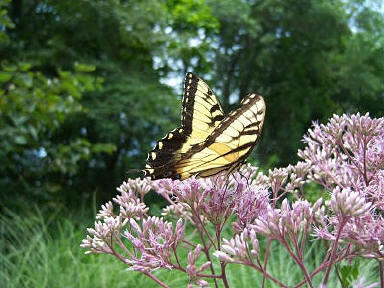 The butterflies and moths that we see each day in summer are practically all native insects. That means that they have evolved, along with the plants that feed them, over centuries. You can help butterflies and moths by providing a suitable habitat of native plants in your
yard that will allow them to grow and thrive.
The butterflies and moths that we see each day in summer are practically all native insects. That means that they have evolved, along with the plants that feed them, over centuries. You can help butterflies and moths by providing a suitable habitat of native plants in your
yard that will allow them to grow and thrive.
A good butterfly habitat is ideally filled with native trees, shrubs and flowers. The nectar plants should be placed in a wind free sunny area, with a few rocks, from which butterflies absorb heat. Butterflies like mud puddles, and need a shallow water source. They also like rotted fruit, which should be placed in a shady area.
The life cycle of a butterfly is egg, caterpillar, chrysalis and butterfly. Each butterfly family has its favorite nectar plants; as well as its favorite (and only) sources of food for its babies (the caterpillars). Butterflies start as an egg laid by the female, who may lay eggs singly, or in clusters, usually on the underside of a leaf on a host plant. When the egg
hatches it eats its shell and then starts eating the host plant leaves. As it grows it sheds its skin a few times. Stages between molts of the old skin are called instars; and they usually don’t look like the caterpillar until the final stage.
Caterpillars eat and eat and eat. When they have reached full size, they attach themselves to a firm support and become a pupa or chrysalis. When the metamorphosis is complete, the butterfly emerges, pumps blood into its proboscis to straighten it out; and into its wings to make them ready for flight. For many species, this all happens in one summer; and some actually
have more than one generation per summer. Other species of moths and butterflies may over winter as eggs, or pupae and emerge the following spring. A brush pile in a corner of your property will provide a good protected location for over-wintering eggs and pupae.
As you read and learn more about butterflies and moths, you will become aware that two types of plants are needed to complete the life cycle. First are the host plants on which the egg develops and matures. Many of the host plants, surprisingly, are trees. The adult butterfly and moth has a much wider range of flowering plants from which it eats nectar.
 Here is a list of common butterflies in our area and the host plants they need: the Monarch host plant is the milkweed family; for the Spicebush Swallowtail, it is spicebush and sassafras tree; Eastern Black Swallowtail larvae eat parsley, tulip tree, fennel and wild cherry; for the Viceroy it’s poplar, willow, cherry and apple; while the Baltimore Checkerspot loves
turtlehead and white ash trees. If you are planning to add a tree to your yard, consider one of these. Always look up mature height, branch spread and water and sun needs of a tree before planting.
Here is a list of common butterflies in our area and the host plants they need: the Monarch host plant is the milkweed family; for the Spicebush Swallowtail, it is spicebush and sassafras tree; Eastern Black Swallowtail larvae eat parsley, tulip tree, fennel and wild cherry; for the Viceroy it’s poplar, willow, cherry and apple; while the Baltimore Checkerspot loves
turtlehead and white ash trees. If you are planning to add a tree to your yard, consider one of these. Always look up mature height, branch spread and water and sun needs of a tree before planting.
Shrub choices include blue spirea, redbud and dogwood trees, lilac, summersweet, and any of the viburnums. These listed bloom at different times of the butterfly season. The best flowering nectar plants have single petals, for easy landing. Also, the butterfly is less able to use the proboscis to find nectar in double flowers.
Here are some flower suggestions: bee balm, Black eyed Susan, hyssop, Joe-Pye weed, purple coneflower, liatris, most herb plants, all the milkweeds, violets, zinnia and Mexican sunflower. The Mexican sunflower will grow to 5 ‘tall and 3 to 4’ wide. Some flowers to attract night flying moths include Nicotiana, Angel trumpet and moon flower.
Butterfly bush (buddleia) is listed on the invasive plant list in many states; however PA is not one of them. I personally do not recommend the plant. There are so many alternatives that are better for our natural environment.
If you want butterflies, stop spraying your yard with a mix of chemicals designed to leave your plants and lawn bug free. Accept the fact that host plants will have holes in their leaves – those caterpillars have to eat! Insecticides and pesticides do not discriminate between an undesirable insect and a caterpillar or butterfly. What kills one will kill the other.
Going native without these chemicals will increase nature’s bug patrol, the birds, in your yard.
Finally, avoid cleaning up every stem, stalk and leaf in the fall. You will be removing over-wintering eggs, larvae or pupae of our butterflies and moths. The birds will enjoy the banquet of seeds provided by the zinnias, coneflower and other plants.
Read other articles on birds, wildlife & beneficial insects
Read other articles by Faith Peterson